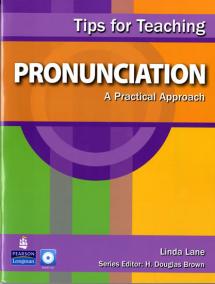Tips for Teaching Pronunciation: A Practical Approach (with Audio CD)
Tips for Teaching Pronunciation shows English language teachers how to teach the North American sound system. This practical reference book provides practical tips, clear explanations, diagrams, and sample classroom activities. Each chapter covers one of the five main areas of pronunciation -- vowels, consonants, stress, rhythm, and intonation. The ...
Detaily o knihe
Počet strán: 296
Rozmer: mm
Jazyk: Anglicky
EAN: 9780138136291
Žáner: Angličtina - výukové materiály
Typ: Paperback
Zákazníci, ktorí si kúpili túto knihu, si kúpili aj...
O knihe
Tips for Teaching Pronunciation shows English language teachers how to teach the North American sound system. This practical reference book provides practical tips, clear explanations, diagrams, and sample classroom activities. Each chapter covers one of the five main areas of pronunciation -- vowels, consonants, stress, rhythm, and intonation. The companion audio CD in the text provides listening material for select activities. Features: *What the teacher should know sections set the scene with pedagogical research. *Concrete tips provide practical classroom suggestions for teaching vowels, consonants, stress, rhythm, and intonation * Sections on Specific Features in each chapter cover common pronunciation problems that teachers find challenging *Sample activities for Specific Feature exemplify how to implement the tips *Practical suggestions show how to integrate pronunciation with other skill areas *Clear diagrams demonstrate how to articulate vowels and consonants * Extensive descriptions help teachers prepare forpronunciation problems common to specific languages groups *Photocopiable diagnostic test and handouts can be used in class with minimal preparation *Audio CD provides listening material for select activities The Tips for Teaching series covers topics of practical classroom-centered interest for English language teachers. Written in clearly comprehensible terms, each book offers soundly conceived practical approaches to classroom instruction that are firmly grounded in current pedagogical research. See also: Tips for Teaching with CALL: Practical Approaches to Computer-Assisted Language Learning Tips for Teaching Series Series Editor: H. Douglas Brown Purpose and Audience -Tips for Teaching- (hereafter TFT) is a series of professional reference books for ESOL teachers and teachers in training on a variety of topics of practical classroom-centered interest. TFT targets teaching in the contexts of ESL in English-speaking countries as well as teachers of EFL in non English-speaking countries. The audience within these contexts is teachers of English in secondary schools, colleges, and adults at varying levels of proficiency. Each book in the series is a practical manual intended to provide the user with clearly conceived methodological ideas, approaches, tasks, activities, and/or techniques to better accomplish their pedagogical goals. General Methodological Characteristics Each TFT book offers background in the underlying pedagogical principles of language learning and teaching in clearly comprehensible terms. This background is meant to provide a brief and concise understanding of theory. These are followed by soundly conceived practical approaches to classroom instruction, from authors who have successfully used the approaches described in the book. TFT methodology is based on communicative and/or task-based language teaching foundations. Student-centered, interactive classroom activities receive primary focus, but not at the expense of appropriate teacher-centered approaches or tasks for individual in-class or homework activity. Market Teachers using TFT books may be novice teachers seeking practical guidelines for approaching instruction in a specified area, or experienced teachers in need of refreshing new ideas. TFT books seek to meet current needs of ESOL teachers, filling a gap in current available publications, or providing better information than other publications. TFT proposals must have a broad enough defined audience for the publication to be financially feasible for Pearson/Longman. Format All the TFT books have numerous practical approaches, activities, tasks, and/or techniques that appeal to their intended audience. They are not simply a listing of -101 techniques,- but rather, offer practical classroom ideas with background foundations, commentary, and guidelines for teaching Books in the TFT series may have different formats depending on the subject matter and approach of an author, but each book in the series should use similar formats/design so readers will be familiar with the approach once they've seen one book in the series. A reader won't want to be disappointed if a book in the series does not have the (ie.) examples or background information that another book has. The books will be visually attractive with an ample number of charts, diagrams, illustrations, and drawings. Enough white space on pages provides an uncluttered look that invites further reading. Prose is limited to a few paragraphs at a time, and is interspersed with figures, tables, bulleted lists, and other visual -breaks.- Chapter organization varies, but the following guidelines generally apply: 1. Each chapter begins with a chapter overview, usually a list of chapter objectives, bulleted summary points, or questions that will be answered. 2. Exercises or other forms of practical applications are offered at the end of each chapter. 3. Photocopy-ready pages of handouts or other pages to support activities may be included. 4. End-of-chapter summary, conclusion, or final comment. Front matter also varies, but the following are commonly included: 1. Author's preface indicating the purpose and audience of the book. 2. Series Editor's preface indicating the place of this book in the series and comments on the importance of the subject matter of the book. 3. Table of contents including subheadings within chapters. Back-matter may include the following: 1. Bibliography of related references. 2. Annotated bibliography of a few selected references that might be of special help to users. 3. Subject index. 4. Glossary, if appropriate. 5. Appendices of photocopy-ready pages for tasks and activities













